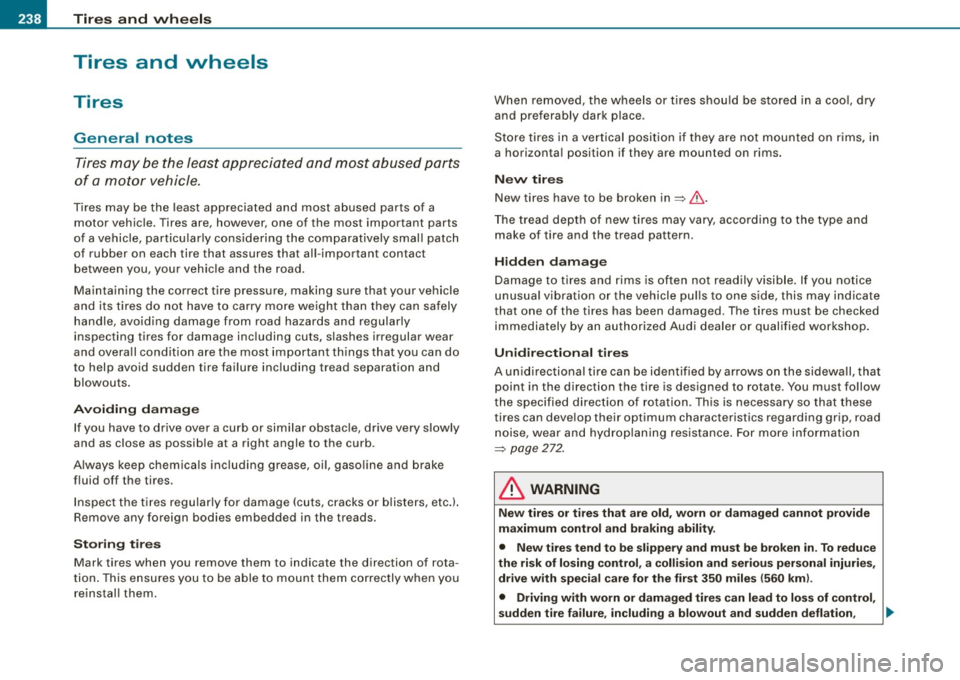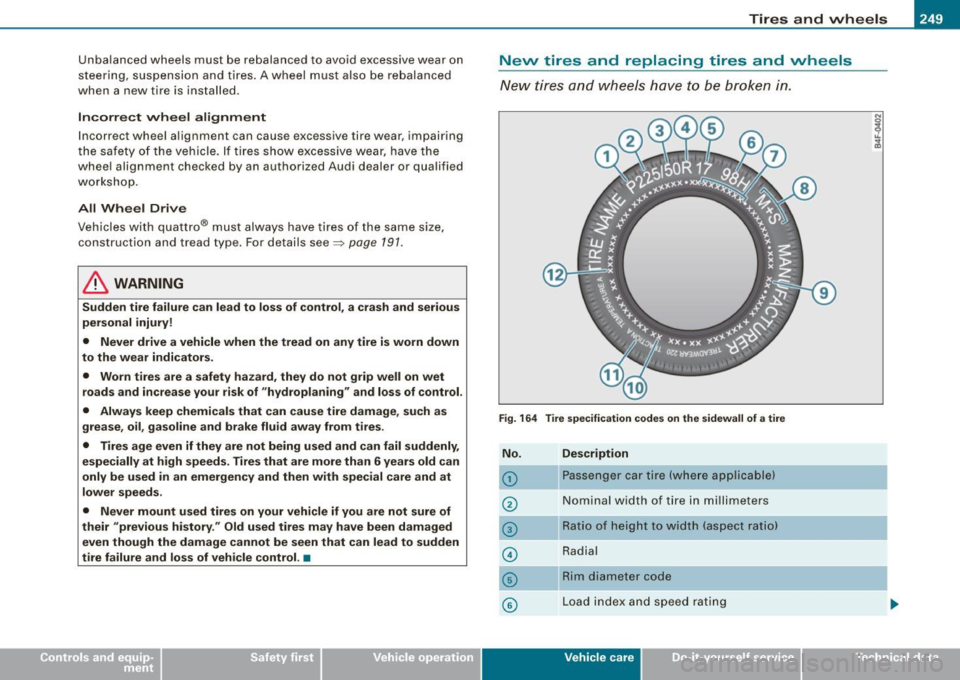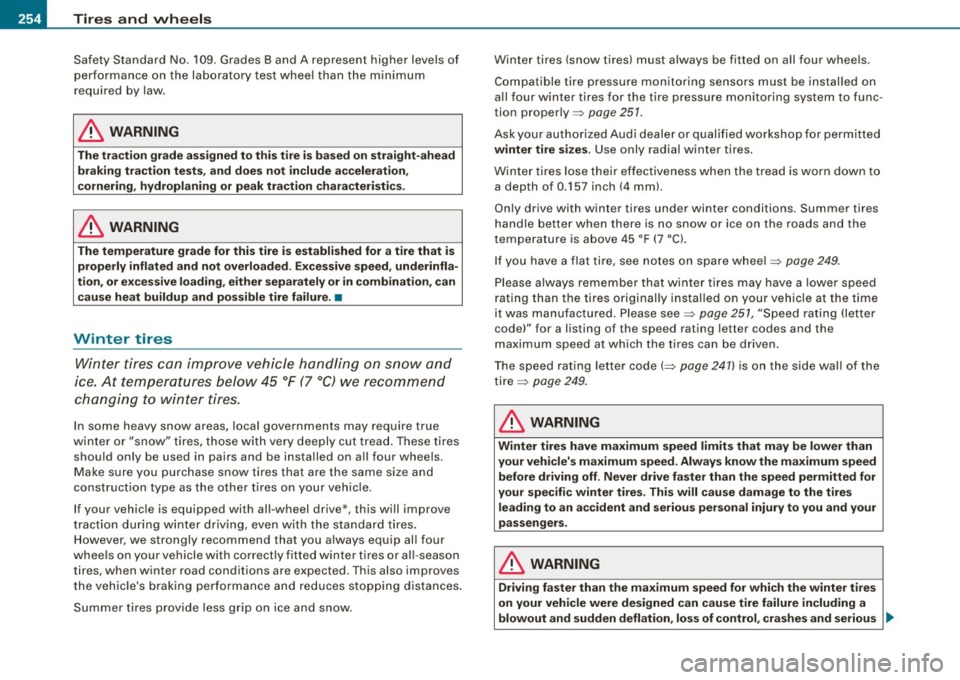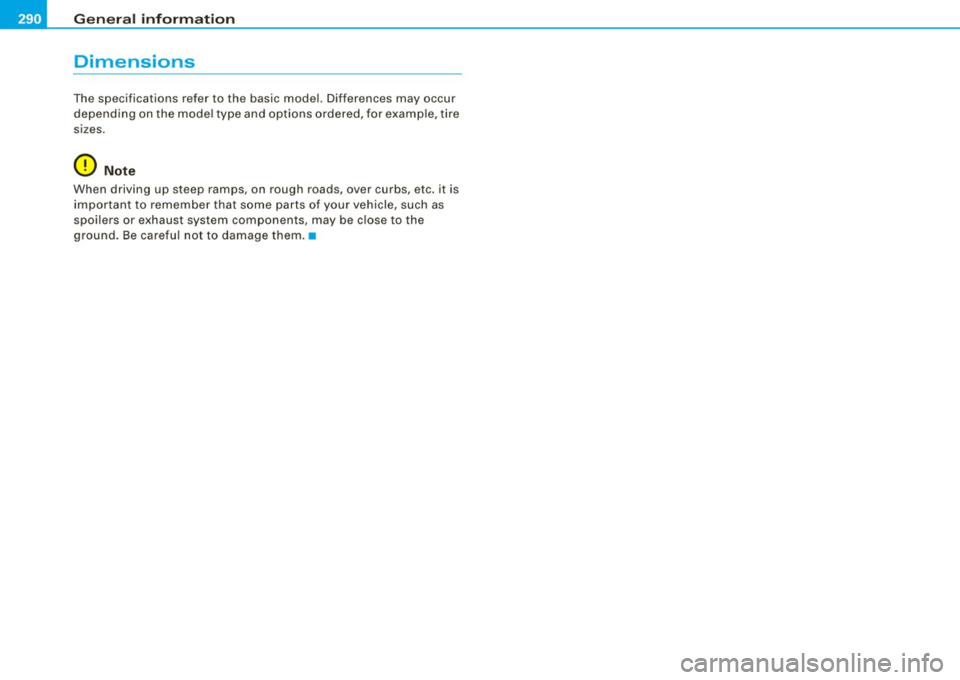2008 AUDI TT ROADSTER tire type
[x] Cancel search: tire typePage 29 of 316

& WARNING
Always observe the posted speed limits and adjust your speed to suit prevailing road, traffic and weather conditions. Never drive
your vehicle faster than the maximum speed rating of the tires
installed. •
Menu display
Introduction
0 ,...
"' 9 .., 00 m
Fig. 15 Wiper lever:
Controls for the menu
display
"'
"'
~ m
Fig . 16 Display: Start
menu
Some functions in your vehicle can be set, activated , and controlled
by
Menus (e.g. Acoustic Park Assist*). With these menus you can
Con tro ls and eq uip
ment
Driver information system
also select the information shown in the DIS display, which operates
only with the ignition switched on. Operation is controlled by the
I Reset) button and the rocker switch on the wiper lever::::, fig. 15.
The Start menu shows you the different display types:
Set
Check
Menu off
Each display type in the Start menu contains a submenu with addi
tional options.
Set
Check
Menu off Clock ::::, page 28
Lighting* => page 71, "Daytime
running lights (DRU
(USA
models)" =>
page 73
Computer ::::, page 28
Acoustic park assist* => page 109
Speed alarm (speed ::::, page 38
warning)
Language (6 languages) => page 28
Units (distance, fuel con-::::, page 28
sumption, temperature)
Wiper (service position) => page80
Window => page 58
Doors (Auto-lock) => page 50
Service ::::, page 25
Vehicle ID number* => page288
Engine oil temperature*
l! AII of the messages shown in vehicles without
menu display appear on the display screen.
•
Vehicle care I I Technical data
Page 240 of 316

-~_T_ ir_e_ s_ a_ n_d _ w_ h_ e_e _l_s _________________________________________________ _
Tires and wheels
Tires
General notes
Tires may be the least appreciated and most abused parts
of a motor vehicle.
Tires may be the least appreciated and most abused parts of a
motor vehicle. Tires are, however, one of the most important parts
of a vehicle, particu larly considering the comparatively small patch
of rubber on each tire that assures that all -important contact
between you, your vehic le and the road.
Maintaining the correct tire pressure, making sure that your vehicle
and its tires do not have to carry more weight than they can safely
handle, avoiding damage from road hazards and regularly inspecting tires for damage inc luding cuts, s lashes irregular wear
and overa ll condition are the most important things that you can do
to help avoid sudden tire failure including tread separation and
blowouts.
A vo iding d am age
If you have to drive over a curb or similar obstac le, drive very slowly
and as close as possible at a right angle to the curb.
A lways keep chemica ls including grease, oi l, gaso line and brake
fluid off the tires.
Inspect the ti res regu larly for damage (cuts, cracks or b listers, etc.l .
Remove any foreign bodies embedded in the treads.
Storing tir es
Mark tires when you remove them to indicate the direction of rota
t ion. This ensures you to be able to mount them correctly when you
reinstal l them. When removed, the wheels or tires shou
ld be stored in a coo l, dry
and preferably dark place.
S tore tires in a vertical pos it ion if they a re not mounted on r ims, in
a horizonta l position if they are mounted on rims.
New tir es
New tires have to be broken in=>&.
The tread depth of new ti res may vary, according to the type and
make of tire and the tread pattern.
H idd en damage
Damage to tires and rims is often not readily visible. If you notice
unusual vibration or the vehicle pu lls to one s ide, this may indicate
that one of the tires has been damaged . The tires must be checked
immediately by an authorized Audi dealer or qualified workshop .
Unidire cti ona l t ires
A unidirectional tire can be identif ied by arrows on the sidewa ll, that
point in the direction the tire is designed to rotate . You must fo llow
t he specified directio n of rotation . This is necessary s o that these
tires can develop their optimum characteristics regarding grip, road noise, wear and hydrop laning resistance . For more information
=>
page 272.
& WARNING
New t ires o r ti re s th at a re old , worn or d am aged cann ot pro vid e
maximum cont rol and braking ability .
• New tires te nd to be slippery and mu st be bro ken in . To redu ce
the ri sk o f lo sin g co ntro l, a collis ion and serious per sonal injurie s,
dri ve w ith special care f or the fi rst 350 m ile s ( 560 km l.
• Driving w ith w orn or damaged tire s can lead to lo ss of control ,
sudd en tir e fa ilure , inc ludi ng a blowout a nd sudden defl atio n, ..,_
Page 251 of 316

__________________________________________________ T_ ir_e _ s_ a_ n _ d_ w_ h_ e_ e_ls _ ____. 111111
Unbalanced wheels must be rebalanced to avoid excessive wear on
steering, suspension and tires. A wheel must also be rebalanced
when a new tire is installed.
Incorrect wheel alignment
Incorr ect wheel alignment can cause excessive tire wear, impairing
the safety of the vehicle. If tires show excessive wear, have the
wheel alignment checked by an authorized Audi dealer or qualified
workshop.
All Wheel Drive
Vehicles with quattro ® must always have tires of the same size,
construction and tread type. For details see
=> page 191.
& WARNING
Sudden tire failure can lead to loss of control, a crash and serious
personal injury!
• Never drive a vehicle when the tread on any tire is worn down
to the wear indicators .
• Worn tires are a safety hazard, they do not grip well on wet
roads and increase your risk of "hydroplaning" and loss of control .
• Always keep chemicals that can cause tire damage, such as
grease, oil, gasoline and brake fluid away from tires .
• Tires age even if they are not being used and can fail suddenly,
especially at high speeds . Tires that are more than 6 years old can
only be used in an emergency and then with special care and at
lower speeds.
• Never mount used tires on your vehicle if you are not sure of
their "previous history ." Old used tires may have been damaged
even though the damage cannot be seen that can lead to sudden
tire failure and loss of vehicle control. •
New tires and replacing tires and wheels
New tires and wheels have to be broken in.
Fig. 164 Tire specification codes on the sidewall of a tire
No.
©
0
©
©
©
©
Description
Passenger car tire (where app licable)
Nominal width of tire in mi llimeters
Ratio of height to width (aspect ratio)
Radial
ii Rim diameter code
Load index and speed rating
Vehic le care
I I irechnical data
Page 254 of 316

-Tires and wheels
P'tr:1-------------------
will not work prope rly . In this case, the tire pressure monitoring
s ys tem would n ot b e ab le to mon itor the tire p ressure or wa rn yo u
if it is necessary .
• The battery inside of the tire pressure sensor has a limited
se rvice life .
• Always d rive with the valve stem caps sec urely mounted . We
recommend using factory insta lled valve stem caps . Ask your au tho
rized Audi dealer to replace lost va lve stem cap s.
The installation o f rep laceme nt tire s wi th steel cor d body p lies in
the tire sidewal l may cause malfunction of the tire pressure moni
t or ing sys tem, a nd is no t re com mended (cord mater ial i nformat ion
in molded on the tire sidewa ll) .
A lw ays check your tire p ressure monito rin g s ystem i ndicator afte r
replacing o ne or mor e tir es o n you r vehi cle. If th e tire p ressu re
monito ring syste m indicat or flashes, o r is on, you r sy stem is not
wo rk in g pr oper ly. Your rep lac em ent ti re mig ht be i nco mpat ibl e wi th
your tir e pressure monitoring syst em , or som e component o f th e
tir e pr ess ure monito ring syste m may be da mag ed.
& WARNING
• Using incorrect or unmatched tires and/ or wheels or improper
tire and wheel combinations can lead to loss of control, collision
and serious personal injury .
• Always use tires , rims and wheel bolts that meet the specifica
tions of original factory -installed tires or other combinations that
have been spe cifically approved by the vehicle manufacturer.
• Tires age even if they are not being used and can fail suddenly ,
especially at high speeds . Tires that are more than 6 years old can
only be used in an emergency and then with special care and at
lower speeds .
• Never mount used tires on your vehi cle if you are not sure of
their "previous history. " Old used tires may have been damaged
even though the damage cannot be seen that can lead to sudden
tire failure and loss of vehi cle control.
& WARNING (continued)
• All four wheels must be fitted with radial tires of the same type,
size (rolling circumference ) and the same tread pattern. Driving
with different tires reduces vehicle handling and can lead to a loss
of control.
• If the spare tire is not the same as the tires that are mounted
on the vehicle -for e xample with winter tires -only use the spare
tire for a short period of time and drive with extra care . Refit the
normal road wheel as soon as safely possible.
• Never drive faster than the maximum speed for which the tires
on your vehicle are rated because tires that are driven faste r than
their rated speed can fail suddenly .
• Overloading tires cause heat build-up , sudden tire failure ,
including a blowout and sudden deflation and loss of control .
• Temperature grades apply to tires that are properly inflated and
not over or underinflated .
• For te chnical reasons it is not always possible to use wheels
from other vehicles -in some cases not even wheels from the
same vehicle model.
• If you install wheel trim discs on the vehicle wheels, make sure
that the air flow to the brakes is not blocked. Redu ced airflow to
the brakes can them to overheat , increasing stopping distances
and causing a collision.
• Run flat tires may only be used on vehicles that were equipped
with them at the fa ctory . The vehicle must have a chassis designed
for run flat tires and a factory -installed tire pressure monitoring
system that indi cate s a loss of tire pressure . Incorre ct use of run
flat tires can lead to vehicle damage or accidents . Check with an
authorized Audi dealer o r tire specialist to see if your vehicle can
be equipped with run flat tires .
If run flat tires are used, they must
be installed on all four wheels . Mixing tire types is not permitted. .,
Page 255 of 316

Tires a nd wh eels -
----------------
•
0 Note
• For technical reasons, it is not genera lly possible to use the
whee l rims from other vehic les. This can hold true for wheels of the
same vehic le type.
• If the spare tire is different from the tires that you have mounted
on your vehicle (for example winter tires or wide p rofile t ires), then
use the spare tire for a short period of time only and drive with extra
care. Rep lace the flat tire with the tire matching the others on your
vehicle as soon as possible.
• If you should put different wheels and tires on your vehic le (e.g.
winter wheels and tires), you must be certain that the wheels and
tires are compat ib le w ith the tire pressure monitoring system.
Otherwise the system will register a malfunction and a fault
message will be displayed . For more informatio n, contact your Aud i
dea ler.
0 Note
• When insta lling new tires, be carefu l not to damage the va lves or
t ire p ressure moni toring syste m sensors .
• Never drive without the va lve stem cap. The va lves could get
damaged.
• I f the sensors must be replaced, then the valve must also be
replaced at t he same t ime.
Uniform tire quality grading
• Tread wear
• Traction AA A B C
• Temperature A B C Qua
lity grades can be found where applicable on the tire side wall
b etween tread shoulder a nd maximum section width =>
page 249,
fig. 164.
For example : Tread wear 200, Traction AA , Temperature A.
All passenger car tires must conform to Federa l Safety Require
ments in addit ion to these grades.
T read wear
The tread wear grade is a comparative rating based on the wear rate
o f t he tire when tes ted under contro lled condit ions on a specified
government test course.
F o r example, a tire g raded 150 would wear one and one half (1 1 /2)
times as well on the government course as a tire graded 100.
The relative performance of tires depends upon the actual condi
tions o f the ir use, however, and may depart sign ificantly from the
norm due to variations in driving habits, service practices and differ
ences in road characterist ics and c limate .
Traction
The traction grades, from highest to lowest, are AA, A, Band C.
Those grades represent the tire 's ability to stop on wet pavement as
measured under contro lled cond itions on specified government
test surfaces of asphalt and concrete. A tire marked C may have
poor t raction performance =>& .
Temperature
The temperature grades are A (the highest), B, and C, represent ing
the tire 's resistance to the generation of heat and its ability to dissi
pat e heat when tested u nder con tro lled co nditions on a specified
indoor laboratory test wheel.
Sustained high temperature can cause the material of t he ti re to
degenerate and reduce tire life, and excessive temperature can lead
to sudden tire failure=:>& .
The grade C corresp onds to a level of performance which all
passenger car tires must meet under the Federa l Motor Vehicle
Vehicle care I t •
Page 256 of 316

-~_T_ ir_e_ s_ a_ n_d _ w_ h_ e_e _l_s _________________________________________________ _
Safety Standard No. 109. Grades Band A represent higher leve ls of
performa nce on th e la boratory test w hee l tha n the minim um
requ ired by law .
& WARNING
The traction grade assigned to this t ire is based on straight-ahead
braking traction tests , and does not include acceleration ,
cornering , hydroplaning or peak traction characteristi cs.
& WARNING
The temperature grade for this tire is established for a tire th at is
properly inflated and not overloaded. Exces sive speed , underinfla
tion, or excessive loading, either separately or in combination , can
cause heat buildup and possible tire failure. •
Winter tires
Win ter tires can im prove veh icle ha ndl ing on sno w and
i c e. A t te mp eratu res belo w 4 5 °F (7 ° C) w e r eco mme nd
c ha ng in g to winter tir e s.
In some heavy snow areas, local governments may require true
winter o r "snow" tire s, those with ve ry deeply cut tread. These tires
should only be used in pairs and be insta lled on a ll four wheels .
M ake s ure you p urchase snow ti res that are the same s ize and
construct ion type as the other ti res on your vehicle.
If your vehic le is equipped with al l-wheel drive *, this will improve
t rac tion dur ing winter dr iv in g, eve n with the standard tires .
However, we strongly recommend that you a lways equip all four
whee ls on y our vehicle with correc tly fitted winte r tires or all-seas on
tires, when winter road conditions are expected . Th is a lso improves
t he ve hic le 's brak ing perfo rmance an d reduces s top ping distances .
Summer ti res p rovide less grip on ice and snow. Winter tires (snow tires) must always be fitted on all four whee
ls .
Compatible ti re p ressure monit oring senso rs must be instal led on
a ll four w inter tires for the tire pressure monitoring system to func
tion proper ly :::::> page 251.
Ask your aut hori zed Audi deale r or quali fied w orksho p for perm itte d
winter tire size s. Use only radial winter tires.
Wi nter tires lose thei r effec tiveness when the tread is worn down t o
a depth of 0. 157 inch (4 mm).
On ly drive with winter tires under winter conditions. Summer tires
h an dle better when there is no s now or ice on t he roads a nd th e
temperature is above 45 °F (7 °C) .
I f you have a flat tire, see n otes on spare w hee l :::::> page 249.
Please a lways remembe r that w inte r tires may have a lower speed
r ating than the tires original ly instal led on your vehic le at the time
i t was manu fac tured. Please see:::::> page 251, "Speed rating (letter
code)" for a listing of the speed rating letter codes and the
m ax imum speed at which t he ti res ca n be drive n.
T he speed rating letter code(:::::, page 241) is on the side wa ll of the
ti re :::::> page 2 49. & WARNING
Winter tires have maximum speed limits that may be lower than
your veh icle's ma ximum speed . Always know the maximum speed
before driving off . Never drive faster than the speed permitted for
your specific winter tires . This will cause damage to the tires
leading to an accident and serious personal injury to you and your
pa ssengers.
& WARNING
Driving faster than the ma ximum speed for whi ch the winter tires
on your vehicle were designed can cause tire failure including a
blowout and sudden deflation , los s of control , crashes and serious _.,
Page 292 of 316

___ G_ e_ n_ e_r_ a _ l_ in_ f_ o _r_m _ a_ t_ i_ o _ n __________________________________________________ _
Dimensions
The specifications refer to the basic model. Differences may occur
depend ing on the mode l type a nd op tions ordered, for examp le, tire
sizes.
0 Note
When driving up steep ramps, on rough roads, over curbs, etc. it is
importan t to remembe r tha t so me parts of your vehicle, such as
spo ilers or exhaust system components, may be close to the
ground. Be careful not to damage them.•